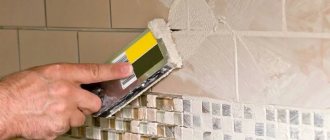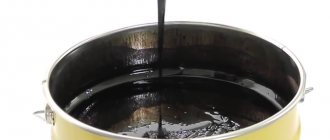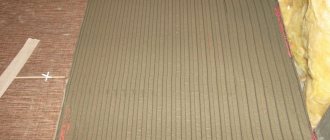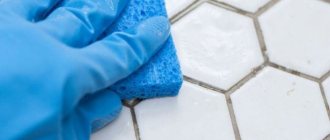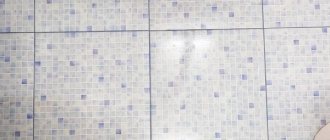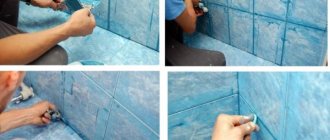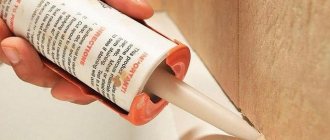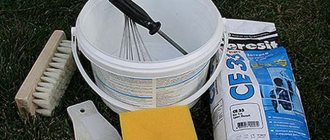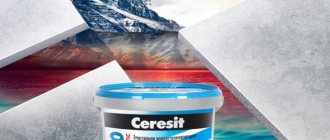Criteria for choosing grout for tiles
Grout for tile joints is a special material designed for filling tile joints at the final stage after laying ceramic tiles. The material performs several functions: it serves as a decorative element, protects the base from moisture, protects joints from contamination, and also prevents the occurrence of mold and mildew. When choosing a grout mixture, professionals are guided by the following criteria:
- uniformity;
- elasticity;
- type;
- color;
- price;
- manufacturer.
A high-quality composition must be uniform and elastic so that no lumps form in the space between the tiles at the time of its application. By type of grout there are cement, cement-sand, epoxy, silicone, and also polymer. More information about the types of grout mixtures is described in the next section.
The color of the material is selected based on the preferences of the home owner. For example, for light tiles it is better to choose white, sand, or beige grout. If the tiles are dark, you can play on contrasts and also choose a light material. Colored tiles require monochromatic combinations: if the tile is purple, then the grout can be pink or a tone lighter than the color of the tile itself.
Fugue is used for tiles and mosaics Source lo.insterne.com
Popular brands among manufacturers include Ceresit, Litokol, Mapei, Sopro. These manufacturers have a wide range and good pricing policy. On average, the cost of grouting starts from 300 rubles for cement mixtures to 3000 rubles for polymer compositions.
Types of grout mixtures
There are several types of grout for joints:
- Cement . This composition is based on cement; additives and color pigments are also used. To use this composition, it is mixed with water to the consistency of thick sour cream. Dry grouting is much more economical, since tilers use the required amount of cement at a time. Sand is added to the composition for wide joints, which, due to its dispersion, fills the joints. The material is easy to use, low cost, durable, but not resistant to mold.
- Epoxy . Such mixtures consist of two components - a hardener and an epoxy resin. The finished mixture looks like a dense elastic mass. This grout is not very popular, but it is resistant to moisture, hardens quickly, is durable and can remain attractive for ten years.
- Polymer . This includes silicone and silicate compounds. Special polymer additives are added to such grouts; the putty is easily washed off and creates a dirt-repellent surface.
Examples of epoxy grout mixture Source ohiogas.info
Cement grout is considered the most popular; epoxy mixtures are less commonly used. Tilers often choose dry compounds, as they have lower consumption and are economical.
Epoxy
We are talking about two-component mixtures of chemically cured resins, to which fine aggregate is added for strength. For this, manufacturers often use colored sand: it not only strengthens the seam, but also acts as a pigment.
Epoxy grout, after introducing the hardener, quickly turns into a dense waterproof mass, similar in properties to plastic. This is the best option for sealing seams when tiling “wet areas” in the kitchen and bathroom, in the pool, bathhouse - in any place with an extremely high level of humidity.
Pros:
- Elastic and completely waterproof;
- Form a pore-free surface that does not absorb moisture or dirt;
- Not afraid of contact with detergents, aggressive chemicals and abrasives;
- Resistant to temperature changes in the range from -20 to +110°C;
- Do not fade or crack, can last up to 30-50 years;
- Wide range of colors - up to neon, luminescent mixtures, metallics and chameleons.
Minuses:
- They require skill when applying, as they harden very quickly;
- Difficult to remove from the tile surface;
- They cost more than other grouts;
- Due to the high sand content, they give a rough surface to which threads and hair cling.
Epoxy grouts have virtually no restrictions on their use - they can even be used outdoors. However, to work with them you need experience, and a lot of it, otherwise you will ruin not only the expensive fugue, but also the tile itself.
What the modern market offers: popular brands and formulations
The market for grout mixtures offers options from foreign and domestic manufacturers. The most popular brands with brief characteristics:
- Ceresit - this kind of fugue has long been a success among tilers, because the company produces easy-to-use cement grouts. Just add water and achieve the desired consistency - the material is ready for use. Latex and epoxy compounds are sold separately. Bulk mixtures are sold in packages of 2 and 5 kg, suitable for joints up to 10 mm. The finished compositions are packaged in buckets of 2 and 5 kg.
- Mapei . An Italian company offering cement and epoxy mixtures. Suitable for 2-5 mm seams, available in 2 and 5 kg packs.
- Litokol . A company from Italy also produces cement and epoxy grouts for joints. Cement compositions require preliminary dilution with water; they are suitable for grouting joints of 1-6 mm. The epoxy base allows the composition to be used for joints of 1-15 mm.
- Kerakoll . The company produces dry and liquid mixtures that are immediately ready for use. Epoxy grouts are suitable for tiles in the bathroom and where there is high humidity. The mineral composition is suitable for seams up to 8 mm in size.
- KIILTO . Manufacturer from Finland, cement mixtures are suitable for narrow joints; they tolerate moisture and air well. Such compositions are packaged in packs of 1.3, 10 and 20 kg.
Manufacturers of grout mixtures Source remontidei.ru
Each manufacturer offers tilers different types of mixtures. Cement-based compounds are more suitable for narrow joints, while ready-made epoxy or latex compounds can be used on larger tile joints.
See also: Contacts of companies that specialize in insulation and finishing of houses.
Color combination options
Thanks to well-chosen color combinations, you can get three options for effects:
- One color. It is the simplest tandem, which is a single whole. A one-color combination is perfect for those who like a laconic, not too catchy design, and also allows you to mask some finishing imperfections in the form of uneven joints or chips.
- Contrasting grout. Gives the environment a special expressiveness and favorably emphasizes the geometry and laying of tile elements, giving them a deeper and richer look.
- Shades. Using this solution, you can unobtrusively highlight the geometric shape, pattern and color of the cladding, thereby creating a calm, expressive design.
The photo shows a bathroom interior with contrasting grout for wall and floor tiles.
Currently, there are collections of tiled models that already have a tinted putty solution. Most often, such a color palette is particularly original, for example, a black finish is complemented by a pearl-white fugue, a beige finish is complemented by grout in chocolate tones, and an olive finish is complemented by graphite.
Features of performing work in stages
Each master knows in his own way how to grout seams on tiles, since different tilers have their own work habits. Despite this, there is a certain algorithm for performing the procedure, which is followed by every specialist. First, a solution is prepared, then the surface is prepared, and the mixture is applied. At the final stage, cleaning work is carried out.
Preparation of the solution
The proportions of cement mixture and water are selected based on the required amount of grout per application. In order for the composition to acquire the desired consistency, water is poured into a container with cement prepared in advance. Then, using a small spatula or spatula, gently mix the resulting mixture until it reaches the consistency of sour cream. The finished composition should be elastic and easily applied into the space between the tiles. Tilers strictly adhere to the proportions indicated on the pack of grout.
This is how the fugue solution is mixed Source leonardo-stone.ru
If you pour more water, there is a risk of getting a mixture that is unsuitable for work. Such a composition will not have strength characteristics, and the grouting of the tiles will be done in violation of the technology. After the solution is prepared, it is left for 10-15 minutes to achieve the desired consistency, after which the tiler uses it for its intended purpose.
Preparation of the seam surface
Before grouting seams on tiles on a wall or floor, craftsmen must carry out preparatory work. For better adhesion, the entire surface of the space between the tiles is cleaned of excess debris, dirt, as well as tile adhesive residues. A paper knife or sharp spatula works well for this. It is carefully placed in the seam and the internal space is cleaned with up and down movements. Tilers do this with caution, as the metal tip can scratch the tile.
Stripping is a mandatory step before grouting. Source plitkahelp.com
Best before date
The grout must be used only within the expiration date indicated on the package. If you neglect this, the fugue may begin to crumble or will not attach to the surface of the tile at all.
Grout must be stored in dry conditions. It is advisable not to spill or pour it out of the package if you do not plan to use the mixture in the near future. From the moment of manufacture, such compositions can be stored for no more than 24 days.
As for the immediate shelf life of grout, it differs for different products. For example, the Atlas mixture can be used for one year if we are talking about an epoxy mixture. The shelf life of glossy versions is 2 years.
Video description
The process is described in more detail in the video:
Tilers make sure that the grout mixture does not protrude beyond the plane of the tile, otherwise it will be difficult to wipe it off later. Ideally, the grout should be slightly pressed into the space between the tiles. Then the master runs a spatula along the seam, removing excess. The tiles embroidered with grout should stand for 24 hours, then you can begin cleaning work.
Finish stage
Some tilers immediately wipe the tiles, others wait until the grout is completely dry. To do this, take a damp cloth and carefully wipe each tile, without touching the space with seams. A white coating may form on the surface of the tile after applying the grout mixture - this must be removed. To do this, use a damp sponge or cloth. Difficulties arise when the tile has a porous surface and the grout mixture eats into the tile relief itself - then it becomes difficult to wipe off the grout.
How to grout joints on the floor
Porcelain stoneware is used as floor tiles for the home - it is easy to lay, has large dimensions, and is also durable and reliable. Every master knows how to grout seams on floor tiles, since the principle of filling voids is identical to the standard work scheme. The difference is that floor tiles are subject to higher wear resistance requirements.
The tiler rubs the mixture over the entire surface Source otvali.ru
In conclusion
Even after you have decided which grout to choose for the tiles, and what shade it should be, take the time to carefully read the manufacturer’s instructions on the packaging, for what size of joints a particular composition is intended and what additional properties it has. If the composition contains sand, then you will have to grout the seams of marble and glazed tiles very carefully so as not to scratch the surface.
The article was written for the site.
Tags: Ceramic tiles
Features of grouting joints on the wall
Fuging the seams gives the tiles a finished appearance. Before grouting the tiles on the floor, craftsmen must treat the walls. The technology for grouting wall tiles is no different from the standard procedure for filling tile joints, but there are several nuances. First, the master must decide on the width of the tile joint. If the tiles have an irregular shape, then tilers choose a width of no more than 10-12 mm. At the same time, you should not make the distance between the tiles too narrow - then difficulties arise when applying the fugue.
A miniature rubber spatula is used for work. Source stroylab.su
After laying the tiles, craftsmen prepare its surface for grouting. To begin with, the space between the tiles is cleaned. This is done with a sharp spatula or screwdriver. In this case, the tile adhesive must dry, so preparation takes place the next day after laying the tiles. When the adhesive is removed, craftsmen use a construction vacuum cleaner to remove any residue in the space between the tiles. The less dust there is between the tiles, the better the grout will adhere.
Cleaned seams are wiped with a damp cloth or sponge - this increases the adhesion of the grout and prevents the material from absorbing all the moisture. Then the master mixes the solution or uses a ready-made fugue using a small rubber spatula. The grout is prepared in a small container; after using a portion, the container must be thoroughly rinsed to remove fugue residue. Grout is applied using standard technology.
When the material has dried, the tilers begin to clean the tiles from the white residue left by the fugue. To do this, use a moistened sponge in plain water and remove the remaining grout from the surface of the tile.
Creating the right shade
colors for creating shades of grout
In some cases, it is not possible to choose the appropriate grout color due to the lack of material in hardware stores or unusual design. In this case, you can use either a universal grout or create your own color. How to change grout color?
You can do this as follows:
- Add tinting paste to the white grout in such an amount to obtain the desired shade. Before starting work, you should mix a small amount of materials with each other and watch the reaction. Since the materials may contain substances that do not interact with the dye or give a completely different shade.
- Use water-soluble color. You should use this type of color in the same way as a paste, having first checked the reaction and determined what tone you will get.
- Mix the material with high-quality gouache or watercolor.
Using the substances listed above, regular grout can be painted any color.
But when using grout with dye, it is important to follow certain rules:
- It is necessary to cover all the seams in one room with this mixture in one day. Since it is difficult to choose a shade, you need to prepare all the material at once so that there are no differences later. If you stretch the repair over several, the shade of the mixture will change each time.
- The mixture needs to be made a little darker than the tile, since it becomes lighter after drying. In order not to make a mistake with the color, it is recommended to mix a small amount of substances and cover a small area at the very bottom with it. When the mixture dries, you will be able to see exactly what color it is.
Thus, there should not be any special problems with the color of the grout material, since the desired shade can be obtained, you just need to simply mix the grout material with color or gouache.
In order not to make a mistake in the proportions, you should make a sample. After all, it is very important to first check the reaction of the substances included in the material to the dye.
Using materials of several colors
tiles with a photo pattern and the use of grout in two tones (dark and light)
Sometimes you can use 2 matching colors for grout. This design option is used when the tiles are of several colors; this option can also be used to create a soft transition of the color of the material from one shade to another, for example, the joints between the tiles can be made white on top and darker on the bottom. You need to buy both materials from the same manufacturer and the same type, since the fusion of colors depends on this.
It is recommended to use this room design option in the following cases:
- If the room has tiles with a photo pattern. In this case, you will need to use many colors to make the drawing look cohesive.
- If different colors of tiles are used.
When decorating a room with multi-colored tiles, you need to be especially responsible when choosing grout, since the wrong shade can ruin the whole idea.
Using one tone
using grout of the same tone
If the room is decorated in soothing colors, then you need to select grout of the same color as the tile or a similar shade. In this case, it is important to choose a grout whose color is as close as possible to the tile.
In order to achieve the ideal tone, it is recommended to proceed as follows:
- Choose several suitable shades and purchase a small amount of each;
- Dilute them at home and see what color they become after drying.
This way you can avoid unnecessary expenses and achieve the desired result. In order not to forget the brands of purchased material, you need to write them down, otherwise the experiment will need to be repeated.
How to update grout for tiles at seams
Over time, the grout on the seams requires updating, as cracks and plaque may form on its surface. Dirt, grease, dust appear at the joints, and the tile seam may darken and begin to crumble.
Chemicals are used for renewal Source ignter.club
Often, fungus or mold appears in the space between the tiles - this is due to a violation of the grout application technology or the use of low-quality grout. To update the seams between tiles, craftsmen use the following means:
- gels for cleaning seams;
- household chemicals in powder form;
- sprays for updating and cleaning seams.
Chemicals are applied to the surface of the seams, left for a certain amount of time, then the composition is washed off with water. For better penetration, use a soft brush - the gel or spray is gently rubbed into the space between the tiles to refresh the condition of the grout.
The process of removing grout from tile joints
If you want to update the fugue between the tile seams, sometimes you resort to radical measures. When the grout on the joints is in poor condition, it must be completely removed to refill the joints. While it is easy to remove just used grout during the grouting process, it is difficult to do so when it hardens. The following methods are used to remove grout from joints:
- chemical reagents - made on the basis of acids, applied to the seams carefully so as not to touch the tiles;
- mechanical method - tilers can use a construction knife, screwdrivers, or a small chisel.
A sharp knife perfectly removes frozen mixture Source acost.ru
If the grout has been in the joints for a long time, then tilers use an electric drill with a thin drill, a jigsaw or a screwdriver.
Latex
Very plastic mixtures that can fill joints up to 2-3 cm wide. They are rarely used in their pure form due to their high cost, but they can be added to cement fugues to improve characteristics or applied as a top reinforcing layer.
Latex grouts are resistant to bending and compression, do not react to temperature changes and retain their color for a long time.
Pros:
- Very elastic;
- They have high resistance to cracking;
- Wide seams glue well;
- Impermeable to water;
- Huge selection of colors.
Minuses:
- Not cheap;
- If you do not remove the fugue from the tiles in time, a cloudy film may form on the surface;
- They do not tolerate steam cleaning well.
Briefly about the main thing
Tile grout is used as a decorative and protective coating for tile joints. It prevents moisture accumulation and the appearance of mold and mildew. When choosing grout, pay attention to its elasticity, color and type: compositions can be cement, epoxy, polymer, latex. The stages of applying grout involve preparing the seams, preparing the mortar and filling the space between the tiles. Over time, the grout requires updating.
Ratings 0
Furanic
The closest “relatives” of epoxy grout are also made on the basis of a curable resin with the addition of latex (to give greater elasticity) or Portland cement, which provides high joint strength.
According to its characteristics, the furan composition after hardening resembles epoxy, only with different chemical properties. It is resistant to aggressive acids, but can react with other substances, releasing harmful compounds into the air, so such grout cannot be used in residential areas.
Pros:
- Impermeable to moisture;
- Forms a very hard seam;
- Resistant to acids and UV radiation;
- Elastic and do not crack over time.
Minuses:
- Difficult to find on the market;
- Available in only one color – black;
- Chemically active;
- Can only be used in industrial premises and outdoors.
